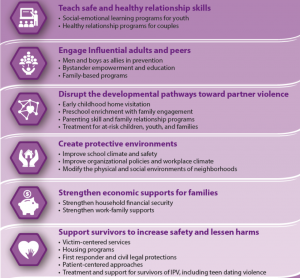
Table of Contents
Contents:
- What is Intimate Partner Violence?
- Facts About Intimate Partner Violence
- Types of Intimate Partner Violence
- Causes and Risk factors of Intimate Partner Violence
- Reasons for the Increase in Intimate Partner Violence
- Consequences of Intimate Partner Violence (IPV)
- Strategies to Prevent Intimate Partner Violence (IPV)
- References and For More Information
What is Intimate Partner Violence?
- Intimate partner violence states to the violence or harm done by the intimate/close partner.
- The term “intimate partner” my include current or former spouses, girlfriends, boyfriends, sexual partners and dating partners. Intimate Partner does not necessarily include sexual intimacy
- ‘Intimate Partner Violence’ refers to any behavior within an intimate relationship that causes physical, psychological or sexual harm to those in the relationship.
- “Intimate partner violence” refers to the physical violence, sexual violence, sexual assault, stalking, or psychological harm by a current or former partner or spouse.
- Intimate Partner Violence may also include harassment by the intimate partner.
Facts About Intimate Partner Violence:
- Around the world, at least one in every four women has been beaten, coerced into sex or otherwise abused during her lifetime according to CDC.
- Intimate partner physical attacks are more than 80 percent in women and stalked by a former or current intimate partner.
- Intimate partner sexual assaults are more than 30 percent in women.
- Intimate partners that stalk are four times further expected than intimate partners in the general population to physically assault their victims and six times more likely to sexually assault their victims.

According to the data from CDC’s National Intimate Partner and Sexual Violence Survey (NISVS):
- 1 in 4 women and 1 in 9 men have experience Intimate Partner Violence in their lifetime.
- 1 in 10 high school students have experienced physical teen dating violence.
- Over 43 million women and 38 million men have experienced psychological aggression by an intimate partner in their lifetime.
- Intimate partner violence includes vicious nature of a human being towards another being in a mutual bond.
- Intimate Partner Violence can differ with regard to the rate and ruthlessness that occurs continuously, extending from one event to another.
- Intimate Partner Violence can occur among both homosexual and heterosexual couples.
Types of Intimate Partner Violence:
Intimate Partner Violence includes four types of violence/behavior
1. Physical violence is when an individual harm or attempts to injure a partner using different types of physical force i.e., hitting, kicking, punching.
Physical violence includes different activities like;
- Scratching, pushing, or shoving
- Throwing, grabbing, or biting
- Choking, shaking, aggressive hair pulling, slapping, punching, hitting or burning
- Use of a weapon
- Use of restraints or one’s body, size, or strength against another person
- Physical violence also includes coercing other people to commit any of the above acts. (CDC, 2016)
2. Sexual violence is the act of compelling or attempting to force a partner to involve themselves in a sex act, sexual touch, or a non-physical sexual event (e.g., sexting) without the partners approval. Sexual violence is considered to be a sexual violence even if it is attempted or completed. Sexual violence is divided into five categories:
-
- Rape or penetration of victim
- Victim forced to penetrate someone else
- Non-physically pressurized unwanted penetration
- Unwanted sexual contact
- Non-contact unwanted sexual experiences. E.g.; unwanted exposure to pornography, verbal sexual harassment etc.
3. Stalking is a pattern of recurrent, unwanted attention and communication by a partner that causes panic or concern for one’s own safety.
4. Psychological violent behavior/aggression is the use of verbal and non-verbal communication with the intent to hurt another person mental or emotional state. According to CDC, psychological aggression can include:
- Expressive aggression (eg, name-calling, humiliating)
- Coercive control (eg, limiting access to transportation, money, friends, and family; excessive monitoring on their personal life)
- Threats of physical or sexual violence; control of reproductive or sexual health (eg, refusal to use birth control; coerced pregnancy termination)
- Exploitation of victim’s vulnerability (eg, immigration status, disability)
- Exploitation of perpetrator’s vulnerability
- Presenting false information to the victim with the intent of making them doubt their own memory or perception (eg, mind games).
Causes and Risk factors of Intimate Partner Violence:
1. Individual Factors:
Individual factors contributing to Intimate Partner Violence are:
- Young age
- Low level of education
- Experience or witness of violence as a child
- Harmful use of alcohol and drugs
- Personality disorders
- Acceptance of violence
- Past history of abusing partner
2. Relationship Factors:
- Conflict and dissatisfaction
- Economic stress
- Having multiple partners
- Differences in educational attainment
3. Community and Societal Factors:
- Gender-inequitable social norms
- Poverty
- Low social and economic status
- Weak legal sanctions and community sanctions against IPV within marriage
- Lack of women’s civil rights, including restrictive or inequitable divorce and marriage laws
- Social acceptance of violence as a way to resolve conflict
- Armed conflict and high levels of general violence in society
Reasons for the Increase in Intimate Partner Violence:
- Child marriage
- Forced marriage
- Traditional male-controlled practices
- Limiting divorce laws
- Lack of victim support.
- Gender inequality
- Lack of education/ sex education
- Poverty
- Dowry system
- Trafficking
- Lack of strict regulation against the rapist or harasser or tormentor
- Lack of family support.
- Women’s hesitation to report on assaults or harassments
- Lack of women supports services or campaigns to motivate and protect women.
- Unwanted pregnancy
- Chronic physical and psychological conditions
Consequences of Intimate Partner Violence (IPV):
- Heart problems
- Depression and other mental health issues
- Gastrointestinal issues
- Post-traumatic stress disorder (PTSD)
- Reproductive problems
- Other physical and mental health issues
- Loss of productivity
- Increase medical expenses
- higher risk for engaging in behaviors such as smoking, binge drinking, and sexual risk behaviors
- Poor self-esteem
- Physical inactivity
- Alcohol and drug abuse
- Self-harm
- Develop sexually transmitted diseases and infections
- Fear, distrust, embarrassment
Consequences of Intimate Partner Violence during pregnancy:
- Miscarriage
- Late entry into prenatal care
- Stillbirth
- Premature labor and birth
- Fetal injury
- Low-birth-weight or small-for-gestational-age infants.
Strategies to Prevent Intimate Partner Violence (IPV):
Strategies Recommended by WHO to Prevent IPV are:
- Reform civil and criminal legal frameworks
- Organize media and advocacy campaigns to raise awareness about existing legislation
- Strengthen women’s civil rights related to divorce, property, child support and custody
- Build coalitions of government and civil society institutions
- Build the evidence base for advocacy and awareness
- Use behavior change communication to achieve social change
- Transform whole institutions in every sector, using a gender perspective; in particular, integrate attention to violence against women into sexual and reproductive health services
- Promote social and economic empowerment of women and girls
- Build comprehensive service responses to IPV survivors in communities
- Design life-skills and school-based programs
- Engage men and boys to promote nonviolence and gender equality
- Provide early-intervention services to at-risk families
Strategies Recommended by CDC to Prevent Intimate Partner Violence are:
- Teach safe and healthy relationship skills
- Engage influential adults and peers
- Disrupt developmental pathways towards pathways violence
- Create productive environments
- Strengthen economic support for families
- Support survivors to increase safety and lessen harms

Additional Measures to Prevent Intimate Partner Violence (IPV):
- Provision of community-based program on gender equity.
- Raising the status of women in society through education, employment opportunities.
- Family support in open discussions about harassment and violence their children might face in college, school and working environment.
- Public enlightenment or clarification on certain myths and the traditional belief that inflames sexual violence in the society or nation.
- Self-defense practices provision to the girls in order to protect himself or herself during violence or attack.
- Strict rules and regulation against minor violence and counseling so there would be less chance of high assassination or violence, especially against the victim.
References and For More Information:
https://www.who.int/violence_injury_prevention/violence/global_campaign/en/chap6.pdf http://www.unwomen.org/en/what-we-do/ending-violence-against-women/facts-and-figures https://www.doorwaysva.org/our-work/education-advocacy/the-facts-about-domestic-violence/ https://www.cdc.gov/violenceprevention/intimatepartnerviolence/index.html
https://www.cdc.gov/violenceprevention/intimatepartnerviolence/fastfact.html
https://www.atrainceu.com/content/3-types-intimate-partner-violence
https://apps.who.int/iris/bitstream/handle/10665/77432/WHO_RHR_12.36_eng.pdf;sequence=1
https://www.chattertons.com/site/private/employment-law-employees/harrasment-and-bullying/ https://www.womenshealth.gov/relationships-and-safety/sexual-assault-and-rape/sexual-assault https://www.marshall.edu/wcenter/sexual-assault/types-of-sexual-assault/ https://www.ncbi.nlm.nih.gov/pmc/articles/PMC4111066/ https://www.cdc.gov/violenceprevention/sexualviolence/prevention.html https://www.cdc.gov/violenceprevention/intimatepartnerviolence/fastfact.html